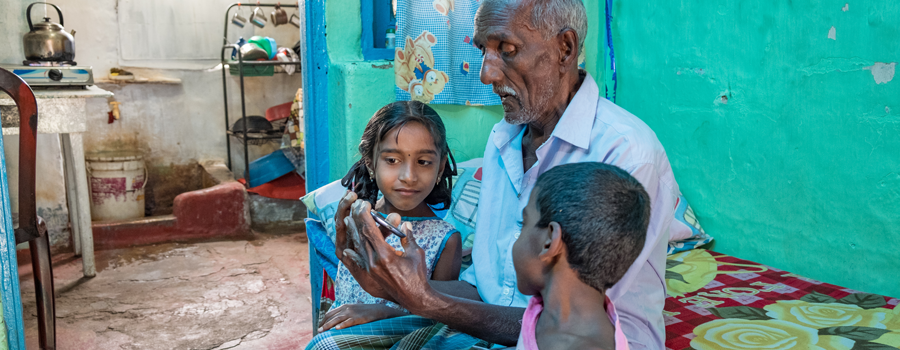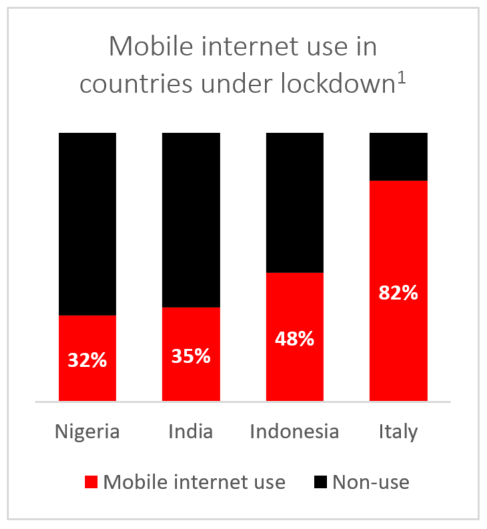Many of us still face unprecedented restrictions to everyday life, following measures to contain the rapid spread of COVID-19. With half of the world’s population now under lockdown, people have turned to the internet to maintain a sense of community, access education or crisis information, and to safeguard a limited level of economic activity.
However, billions of people are still unfamiliar with the internet or find themselves in a digital desert, especially in low- and middle-income countries (LMICs), where many struggle with the consequences of quarantine. This lack of internet use not only excludes individuals from opportunities to overcome the social and economic limitations of self-isolation, but also limits the ability of governments to effectively manage the pandemic and its economic fallout.
In the short term, we can collectively benefit from insights into the crisis responses of mobile operators and governments addressing the barriers for more people to go online. We will therefore share experiences from LMICs over the next few weeks, in an effort to ensure an increasing number of people can benefit from digital tools to cope with the impact of COVID-19. This first of the series focuses on the obstacles to digital inclusion.
The challenge is significant: Across the globe, 3.3 billion people do not use the internet[1], while having access to it – the ‘usage gap’. In addition, 600 million people are living outside of a mobile broadband network altogether. There are some significant regional disparities, with a 59 percent usage gap in South Asia and 24 percent in Europe. In India, where the COVID-19 lockdown of 1.3 billion people has recently been extended, GSMA Intelligence data shows that just 35 percent of the population is online. In Nigeria this is 32 percent, with almost 100 million people not using the internet, despite having access.
This limited use of internet services hampers the ability to effectively mitigate the impact of the lockdowns imposed across countries and cities:
- Digital tools are being deployed to improve access to overloaded healthcare services[2], while protecting the largely insufficient capacity of medical staff in many LMICs. Some 1.3 billion subscribers were using mobile health services last year, which is set to surge because of COVID-19[3];
- Following the closure of schools and other educational institutions, the 1.5 billion students and youth affected now depend on distance learning[4]. Although 1.4 billion mobile subscribers already use a phone to improve their education or that of their children3, the shift to online solutions for remote learning is leaving many behind. Some governments have had to turn to non-interactive technology, such as radio and TV, to provide a minimum level of educational continuity for those unable to use the internet[5];
- The limited uptake of digital services in LMICs is also preventing businesses from moving to e-commerce or other online platforms to safeguard some level of continued consumption, as well as complicating the distribution of potential financial support programmes, despite a recent surge in mobile financial services uptake[6].
- The effective distribution of crisis communications also largely depends on digital channels and the capability of individuals to discern manipulated information from trusted sources, posing a challenge for those who have not been online before.
There are various reasons why internet use is trailing network coverage. Affordability of devices and services, digital literacy and skills, locally relevant services, online safety and security as well as accessibility to enabling infrastructure, such as electricity and formal identification, have been found to be the most important barriers to internet usage. For example, the GSMA’s State of Mobile Internet Connectivity report shows that in half of LMICs the cost of 1GB exceeds the United Nation’s affordability target, while just 11 percent of people in Sub-Saharan Africa are on social media. Many individuals lack the digital skills to be online, with currently just 45 percent of the world population equipped with basic digital skills, while less than 30 percent has the standard digital skills needed to find and download new software for example[7]. Women are disproportionately affected, as they are 20 per cent less likely to use the mobile internet than men[8], which is most challenging in South Asia with a 51 percent gender gap, and Sub-Saharan Africa ranking second at 37 percent. These five barriers to internet use are key to framing the discussion on which policies to pursue to empower more people with the digital tools needed in this time of crisis and beyond.
There has never been a more relevant time to share practical insights and jointly think about creative policies that address the barriers to internet use in places that are hardest hit by COVID-19. Especially now that governments are deciding on economic support packages that will shape societies for decades to come, digital strategies should be prioritised. Although the internet cannot replace the need for physical proximity, it is proving to be indispensable to mitigate the social and economic fallouts from the measures taken to contain the virus. Let’s make sure that everyone has an equal opportunity to participate and overcome the challenges so many of us face today.
Beyond COVID-19, addressing the challenges of internet adoption and use is a long term objective, and the GSMA Connected Society programme is starting a project to identify policy solutions and best practices for the expansion of mobile internet use in LMICs. Share your views and experiences from your country on Twitter using the hashtag #DigitalInclusionPolicy and tagging @GSMAm4d.
Our next blog in this series will cover digital skills.




